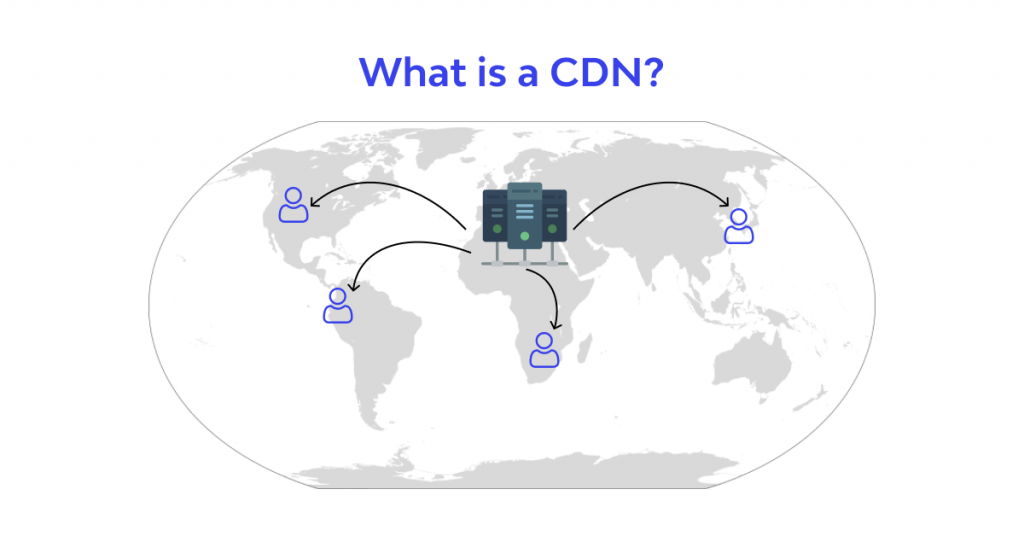- What is CDN?
The Content Delivery Network (CDN) is a network of servers that store copies of static content within a website and distribute it to multiple PoP servers. The network of CDN servers is located all over the globe. From PoP (Points of Presence), data will continue to be sent to the end user. Through CDN, a copy of the content on the nearest server is returned to the user when they visit the website.

- How does CDN work?
A content delivery network (CDN) works by establishing a point of presence (POP) or a group of CDN edge servers in multiple geographic locations. This geographically distributed network works on the principles of caching, dynamic acceleration, and edge logic computation.

Caching
Caching is the process of storing multiple copies of the same data for faster data access. In computing operations, the principle of caching applies to all types of memory and storage management. In CDN technology, this term refers to the process of storing the static content of a website on many servers in the network. Caching Operations in CDN work as follows:
- A geo-located remote site visitor will make the first request for static web content from the site.
- That request will go to the web application server or origin server. The origin server sends a response to that remote visitor. At the same time, the origin server also sends a copy of the response to the CDN’s POP in the closest geographical location to that visitor.
- The CDN’s POP server will store the copy as a cached file.
- Next time, when this or any other visitor in that location makes the same request, the cache server, not the origin server, will send the response.
Dynamic acceleration
Dynamic acceleration is the process of reducing server response times to requests for dynamic web content by having a CDN server intermediate between web applications and clients. Caching won’t be easy with dynamic web content because the content can change with every user’s request. CDN servers must reconnect to the origin server when there are any dynamic requests, however, they help speed up the process by optimizing the connection between these servers and the origin server.
If the client sends a dynamic request directly to the web server over the Internet, the request may be lost or delayed due to network latency. Opening and closing connections for security verification purposes can also be time-consuming. On the other hand, if a nearby CDN server forwards requests to the origin servers, they have established a reliable, persistent connection. For example, the following features can further optimize the connection between them:
- Intelligent Routing Algorithms
- Neighborhood by geographical location with the origin server
- The ability of the client to process the request, which reduces the size of the request
Calculating boundary logic
You can program the CDN edge server to perform logical calculations that simplify client-server communication. For example, this server can perform the following tasks:
- Examine user requests and modify caching behavior.
- Validate and handle incorrect user requests.
- Modify or optimize content before responding.
Distributing application logic between web servers and the edge helps developers offload the origin server’s compute requirements and improve site performance.
- What is the use of CDN?
Content Delivery Networks (CDNs) help improve the normal functionality of the website while increasing customer satisfaction. Here are some typical use cases.
CDN response time is fast
CDN ensures website loading speed, online transactions are always smooth and stable. Users will appreciate sites with fast response times. This can also significantly increase the revenue the website brings in.
Toward the global market
If your website server is in only one country and you do not use a CDN, it will be difficult for you to reach other countries. The reason is that remote customers cannot access the website easily and quickly due to distance problems.
Global CDN service will help you serve more customers around the world because the access speed of the clients will be improved by servers distributed locally in the country where they live.
Helping businesses save costs
Instead of investing in infrastructure to have servers in multiple locations, a CDN service can help businesses and businesses save on large bills. CDN provides a platform. A single service can handle all operations separately. It’s also possible works well in many regions of the world for a very reasonable price.
Ensure users can access all times
CDN companies have servers everywhere. If a server has a problem that needs to be fixed. The user will be redirected to another server nearby. This will secure your website will always be visited by users. And greatly enhance the reputation and brand of the website.
Reduce server load and increase users when using CDN
The user will not refer to the website’s server directly. Which will be transmitted through servers located around the world. All of these servers contain the same website resource information. So the user experience is completely unaffected.
Due to such a reduction in load, more people can be active on your site at the same time. Because then the bandwidth is divided equally among the server areas closest to each user.
CDN Limits DDoS Attacks

DDoS attacks can cause enormous financial losses. And seriously damage the image of the company. A CDN can help you prevent such attacks.
Since CDNs are built with a distributed architecture, the infrastructure is also protected. The core is also protected by the firewall behind the CDN. Therefore, the possibility of a DDoS attack is also greatly reduced.


Recent Comments